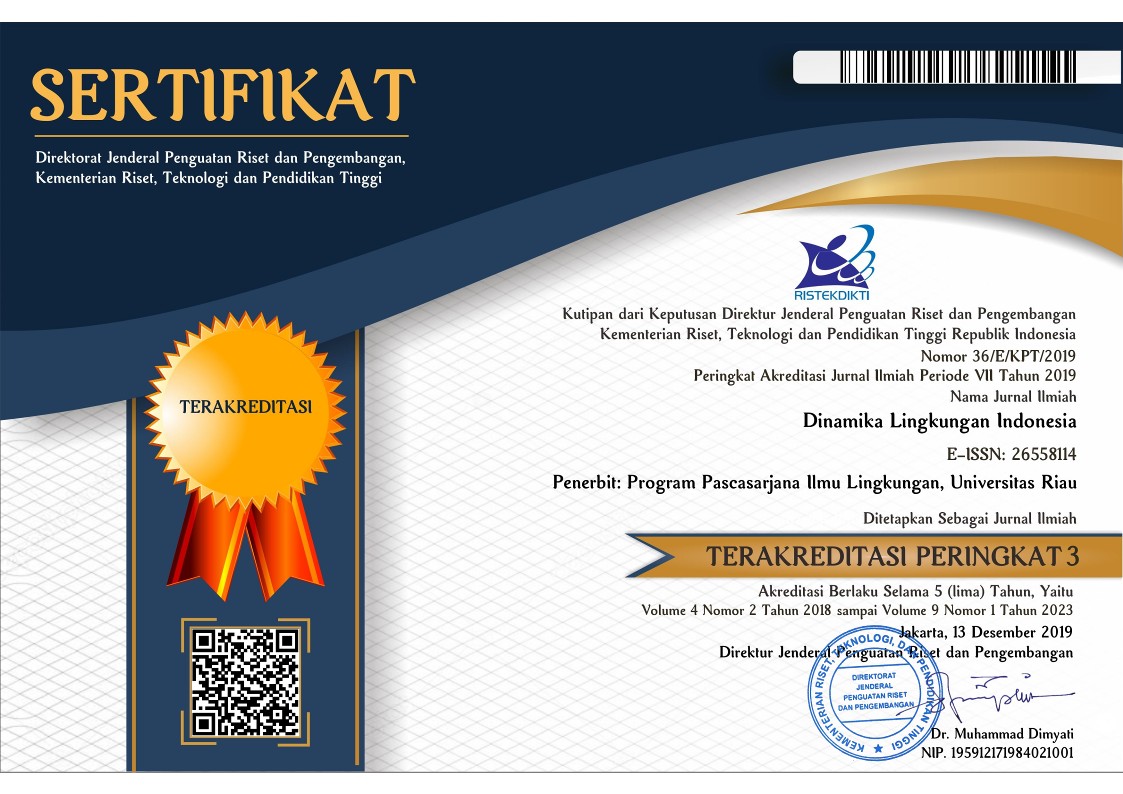Implementasi Model Soil dan Water Assessment Tool (SWAT) Dalam Pengelolaan Das Mikro Sei Tanduk
Abstract
The Soil and Water Assessment Tool (SWAT) model which is integrated with the Geographic Information System (GIS) can provide an overview or prediction of the influence of land management on the hydrology of the Micro Sei Tanduk watershed in accordance with the interests of evaluating and monitoring watershed management activities. The purpose of this study was to analyze the management of the Sei Tanduk Micro watershed based on land use patterns, as a basis for determining the best recommendations for planning and evaluating the Indragiri Rokan Watershed Management Project Activities for Fiscal Year 2003 by compiling a Master Plan for the Micro Sei Tanduk Watershed Master Plan Rumbio Village, Kampar Regency. The research method is to process primary and secondary data using a SWAT model that is integrated with GIS in analyzing hydrological characteristics in land use scenarios in the management of the Micro Sei Tanduk watershed, as a basis for providing recommendations. The best recommendation from the evaluation and analysis of the Micro Sei Tanduk watershed management based on land use patterns is scenario 2 in the form of applying agroforestry on mixed dry land agriculture with the insertion of forestry trees based on community participation in the Micro Sei Tanduk watershed, Rubio Village, Kampar District, Kampar Regency.
Keywords
Full Text:
PDFReferences
Abbaspour, K. C. (2015). SWAT-CUP: SWAT calibration and uncertainty progrms-a user manual. Ewag: Swiss Federal Institute of Aquatic Technology.
Andono, R., Limantara, L. M., & Juwono, P.T. (2014). Studi penilaian indikator kinerja DAS Konaweha akibat perubahan tata guna lahan berdasarkan kriteria hidrologi. Jurnal teknik Pengairan, 5 (1), pp. 54 – 60. https://jurnalpengairan.ub.ac.id/index.php/jtp/article/view/204.
Asep, M. & Zaenal, M. (2015). Pendapatan Petani, Kajian Kontribusi Sistem Agroforestri Terhadap Pendapatan Petani, (Studi Kasus: Desa Cibatok Dua, Kecamatancibungbulang, Kabupaten Bogor, Provinsi Jawa Barat), Jurnal Nusa Sylva, 15 (1), pp., 11 – 16. https://doi.org/10.31938/jns.v15i1.128.
Balai Pengelolaan DAS (BPDAS) Indragiri Rokan. (2003). Model Rencana Induk Model DAS Mikro Desa Rumbio Kecamatan Kampar Kabupaten Kampar, DAS Mikro Tanduk Kampar, Proyek Perencanaan dan Evaluasi Pengelolaan DAS Indragiri Rokan Untuk Fiskal. Direktorat Jenderal Rehabilitasi Lahan dan Perhutanan Sosial, Departemen Kehutanan Republik Indonesia. 2003.
Balai Pengelolaan DAS (BPDAS) Indragiri Rokan. (2016). Laporan Monitoring dan Evaluasi Tata Guna Lahan dan Pengelolaan Air Sosial Ekonomi DAS Mikro Sei Tanduk. Direktorat Jenderal Rehabilitasi Lahan dan Perhutanan Sosial, Kementerian Kehutanan Republik Indonesia, (2016).
Ferijal, T. (2012). Prediksi hasil limpasan permukaan dan laju erosi dari Sub DAS Krueng Jereu menggunakan model SWAT. Jurnal Agrista, 16 (1), pp. 29 – 38.
https://jurnal.unsyiah.ac.id/agrista/article/view/680.
Firdaus, G., Haridjaja, O., & Tarigan, S. D. (2014). Analisis respon hidrologi terhadap penerapan teknik konservasi tanah di Sub DAS Lengkong menggunakan model SWAT. Jurnal Tanah Lingkungan, 16 (1), pp. 16 – 23. https://doi.org/10.29244/jitl.16.1.16-23.
Hunink, J.E., Niadas, I.A., Antonaropoulus, P., Droogers, P., & de Vente, J. (2013). Targeting of intervention areas to reduce reservoir sedimentation in the Tana catchment (Kenya) using SWAT. Hydrologica Sciences Journal, 58 (3), pp. 1 – 15. https://doi.org/10.1080/02626667.2013.774090.
Mechram, S, M., Mawardi & Sudira P. (2000). Aplication model AVSWAT to predict surface runoff, erosion, and sedimentationin Keduang Watershed: Upper Bengawan Solo.
Moriasi, D. N., Arnold, J. G., Van Liew, M. W., Biginer, R. L., Marmel, R. H., &Veith, T. L. (2007). Model Evaluation Guidelines for Sistematic Quantification of Accuracy in Watershed Simulations, Journal ASABE, 50 (3), pp. 885 – 900. https://agris.fao.org/agris-search/search.do?recordID=US201300848936.
Mubarok, Z., Murtilaksosno, K., & Wahjunie, E. D. (2015). Response Of Landuse Change On Hydrological Characteristics Of Way Betung Watershed - Lampung, Jurnal Penelitian Kehutanan Wallacea, 4 (1), pp. 1 – 10. http://dx.doi.org/10.18330/jwallacea.2015.vol4iss1pp1-10.
Nurdin, Syaiful, B., Zulkarnai., & Sukendi. (2019). Hydrological Characteristics Analysis Due To Changes In Land Use With The Swat Model In The Koto Panjang Hydropower Catchment Area, International Journal of Civil Engineering and Technology (IJCIET), 10 (2), pp. 330–340. https://sdbindex.com/Documents/index/00000001/00000-06270.
Ramadhani, E., Suprayogi, S., & Hadi, M. P. (2021). Pengaruh Perubahan Penggunaan Lahan Terhadap Limpasan Menggunakan Multidata Iklim Satelit di Sub DAS Samin, Jurnal Ilmu Pertanian Indonesia (JIPI), 25 (4), pp. 503 – 514. https://doi.org/10.23887/mkg.v22i1.30589.
Ridwan, P., Sudira, S., Susanto., & Sutiarso, L. (2013). Manajemen sumber daya air DAS Sungai Sekampung di antara Bendungan Batu Tegi dan Bendungan Agroguruh Propinsi Lampung: Kerangka analitis penyusunan pola operasional waduk harian . Jurnal AGRITECH, 33 (2), pp. 226 – 233. https://doi.org/10.22146/agritech.9801.
Staddal, I. (2016). Analisis Aliran Permukaan Menggunakan Model SWAT Di DAS Bila Sulawesi Selatan, Jtech, 4 (1), pp. 57. https://doi.org/10.30869/jtech.v4i1.53.
DOI: http://dx.doi.org/10.31258/dli.10.1.p.38-44
Refbacks
- There are currently no refbacks.

This work is licensed under a Creative Commons Attribution 4.0 International License.





